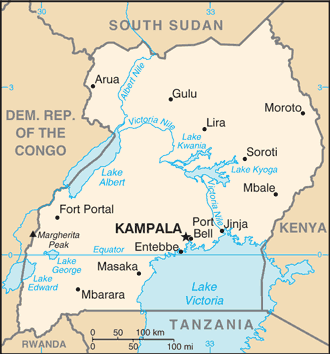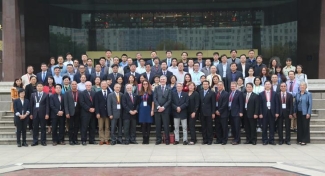Providing safe transfusions in the developing world
Thursday, February 23, 2017 Dr. Kendra Hodgkinson
When someone loses a lot of blood or has blood that doesn’t work properly, transfusions are critical for saving that person’s life. In Canada, Canadian Blood Services and Héma-Québec work hard to provide a very safe and — thanks to our generous blood donors — consistent supply of blood products for transfusions.
But how can a hospital deliver safe blood transfusions in a country where…
- There aren’t enough units of blood available to transfuse everyone who needs it?
- Serious transfusion-transmissible infections such as HIV and malaria are common?
- Funding for staff, equipment and supplies is inadequate and inconsistent?
Dr. Heather Hume knows all about these challenges. Dr. Hume, a professor at the University of Montreal and former executive medical director for Canadian Blood Services, works six months every year as a pediatric hematologist at the Mulago National Referral Hospital in Uganda. She recently visited Canadian Blood Services to share her experiences with staff at a Knowledge Infusion learning event.
Shortage of blood products
In the large Ugandan hospital where Dr. Hume works, there are many days when there is no group O blood available for transfusions. The blood supply is very limited and quickly overwhelmed by the demand; blood is frequently needed to save the lives of mothers with postpartum hemorrhaging (more than 30,000 babies are delivered each year at the Mulago National Referral Hospital) and victims of traffic accidents.
Many cultural and systemic factors contribute to the low rate of blood donation in Uganda. There is widespread misinformation about the risks of donating blood, and many people are unable to donate due to their HIV status or other health conditions. As a result, Uganda has a critically low supply of blood available for transfusions.
Challenge of providing safe transfusions
 In Sub-Saharan Africa, including Uganda, high rates of HIV and other transfusion-transmissible infections are a major obstacle to providing safe blood products for transfusions. In Uganda, about 7 per cent of the adult population is living with HIV – 35 times the rate in Canada (0.2 per cent).
In Sub-Saharan Africa, including Uganda, high rates of HIV and other transfusion-transmissible infections are a major obstacle to providing safe blood products for transfusions. In Uganda, about 7 per cent of the adult population is living with HIV – 35 times the rate in Canada (0.2 per cent).
Because even the most sophisticated tests are not perfect, the risk of HIV infection from a transfusion is very real in Uganda. That risk is far, far lower in Canada (estimated at 1 in 21 million). Our eligibility criteria are frequently reviewed and updated to ensure that they are based on the most up-to-date scientific knowledge available. The donor screening process in Uganda is difficult because (1) many people infected with HIV do not fall into easily identifiable categories; (2) risky behaviours are highly stigmatized; and (3) many people do not know their HIV status. As a result, almost one in a hundred blood donations in Uganda tests positive for HIV.
Even if the blood products are safe, they may be delivered in an unsafe way. For example, transfusing the correct blood type is critical for the recipient’s safety — but the blood type of the donor and/or recipient are often mislabelled because systems are not fully automated and patients do not have ID bands. It is sometimes challenging to correctly identify patients because Ugandan culture places less importance on birthdates and consistent spelling of names. A patient might spell her name differently each time she is asked; another patient may not know his date of birth. Making things more challenging, many Ugandan names have very similar spelling.
Limited resources
Even when there is blood available for transfusion, limited resources can cause problems. To provide safe transfusions, health-care providers require laboratory equipment for testing and processing donor blood, medical equipment to collect and transfuse the blood, and various consumable materials. This can be difficult when budgets are extremely limited and delivery systems are unreliable. As a result, important blood tests are sometimes not done.
Higher-income countries have helped provide both funding and material support. For example, when Canadian Blood Services recently amalgamated its labs and no longer needed a machine used for certain blood tests, it was donated to the Mulago National Referral Hospital. However, this strategy has its own challenges, such as adapting the donated equipment to the local environment (for example, different voltage requirements), and funds may be so limited that paying to transport and maintain a donated machine is not feasible. It may also be difficult to keep the machine consistently supplied with the blood test reagents needed – even something as simple as saline has been a challenge.
Moving forward
Health-care providers in low-income countries will always have many challenges. However, much has improved over the past few decades, and there is much more work still to be done.
Blood safety experts around the world contribute to global improvements in transfusion medicine by participating in regular meetings organized by the World Health Organization. These meetings are used to exchange knowledge, develop collaborations, and identify priority areas for improvement. One recent meeting (2013) had 250 participants including a representative from Canada (Dr. Marc Germain from Héma-Québec).
Blood products in Uganda are much safer than they used to be. The HIV prevalence in Uganda has fallen since 1990, when it was nearly 15 per cent. National campaigns that address stigma (such as home-based HIV counselling and testing) have increased voluntary HIV testing. The donor selection process has also been refined, cutting the percentage of HIV-positive Ugandan blood donors in half from 2004 to 2009.
A cultural shift towards altruistic blood donation has been encouraged through blood drives and targeted campaigns. Education is underway to reduce donor fears and improve the safety and efficiency of transfusion processes. Technological advances may also help; new techniques that reduce pathogens such as HIV in plasma products are already used in many countries, although more research is needed before these can be used for other blood products.
As Dr. Hume says, we “often cannot use the same solutions as those we are used to in high income countries, but that does not necessarily mean that there is not a solution!”
Further reading:
A shared love of volunteerism, Queen's Alumni Review 2015 (p.46)
Platelet transfusion therapy in sub-Saharan Africa: bacterial contamination, recipient characteristics, and acute transfusion reactions in the journal Transfusion 15 April 2016.
Canadian Blood Services – Driving world-class innovation
Through discovery, development and applied research, Canadian Blood Services drives world-class innovation in blood transfusion, cellular therapy and transplantation—bringing clarity and insight to an increasingly complex healthcare future. Our dedicated research team and extended network of partners engage in exploratory and applied research to create new knowledge, inform and enhance best practices, contribute to the development of new services and technologies, and build capacity through training and collaboration.
The opinions reflected in this post are those of the author and do not necessarily reflect the opinions of Canadian Blood Services nor do they reflect the views of Health Canada or any other funding agency.
Related blog posts
Canadian Blood Services staff part of a team of experts who organized the first international leadership workshop on organ donation and transplantation in Beijing, China.
The 2016 Transfusion Science Education Course – a Canadian Blood Services, Grifols partnership.

